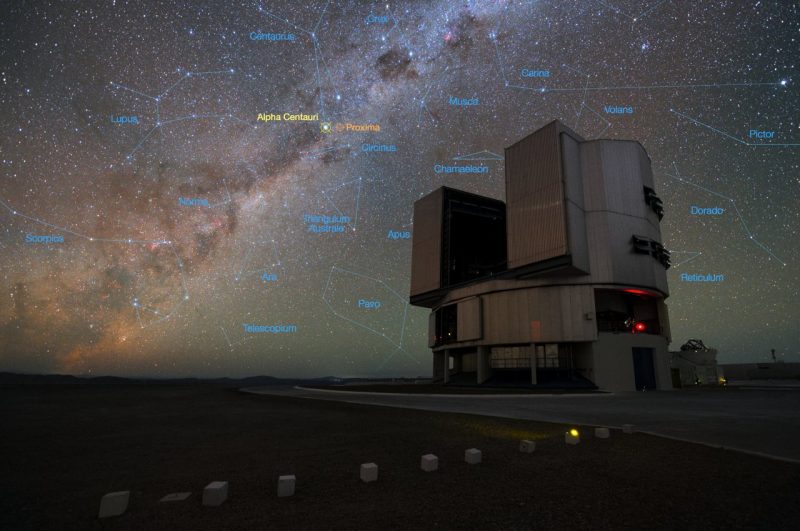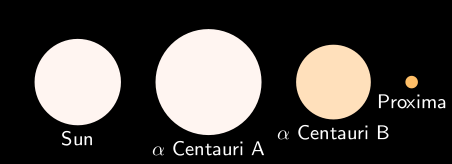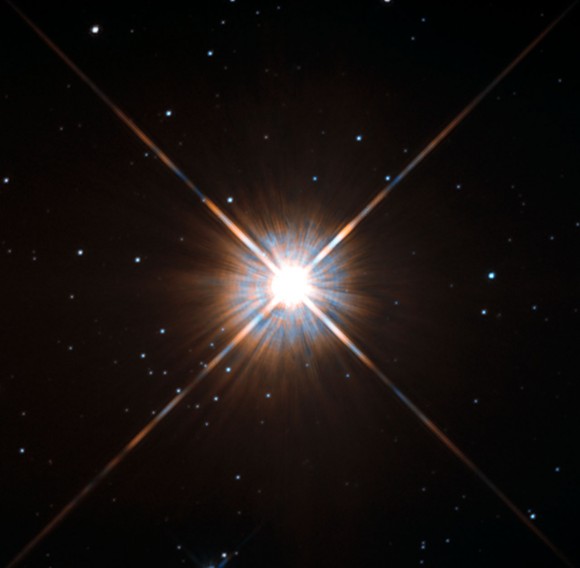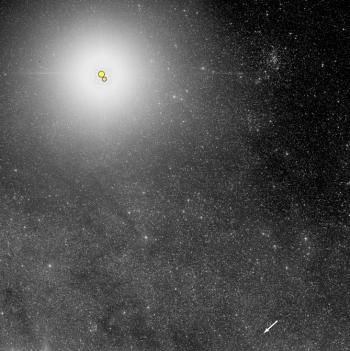

The foreground of this image shows the Very Large Telescope of the European Southern Observatory (ESO). In August 2016, ESO announced a planet orbiting the star Proxima in the Alpha Centauri system. Astronomers call it Proxima b, and it’s now the nearest known exoplanet to Earth. See a list of the nearest exoplanets. Image via ESO.
The Alpha Centauri system is the closest star system to our sun. On our sky’s dome, we see this multiple system as a single star and the third-brightest star visible from Earth. Alpha Centauri is part of a double, or triple, star system. The two main components are Alpha Centauri A and Alpha Centauri B. The third star, a red dwarf called Proxima Centauri, is about 4.22 light-years distant and is actually our sun’s closest neighbor among the stars. Is it gravitationally bound to the other two stars? Scientists are still arguing about that. More about it below.
If you looked through a small telescope at the Alpha Centauri system, you’d see the two main stars, but you wouldn’t see Proxima Centauri. It’s too faint and appears too far (four diameters of the full moon) away to be easily recognized at part of the system.
In 2016, scientists announced a planet for Proxima, called Proxima b

A comparison of the sizes and colors of the stars in the Alpha Centauri system with our sun. Image via Wikimedia Commons.
Proxima is the closest of Alpha Centauri’s three stars to Earth. Faint red Proxima Centauri is nearly a fifth of a light year from Alpha Centauri A and B. This great distance is what calls into question its status as part of a triple star system. In other words, there’s some debate about whether Proxima is truly bound to the other two stars of the system. Is it? Its status is unclear. It might simply be passing nearby but not part of the system. Still, we say – and others say – that Alpha Centauri is the closest star to our solar system, with the assumption that Proxima is a true part of the Alpha Centauri system.
Let’s look at Proxima’s distance from the other two stars in the Alpha Centauri system another way. Proxima’s orbit around the two primary stars is thought to take as long as half a billion years.
What’s more, Proxima Centauri is a pipsqueak of a star. It’s a red dwarf star with only about an eighth of the mass of our sun. If Proxima replace the sun in our solar system, it would shine only as brightly as 45 full moons. Meanwhile, our sun is 400,000 times brighter than a full moon.
Proxima is also a flare star subject to sudden changes in brightness. Its flares are really feeble, though. On a brighter star, they might not have been noticed.
So let’s assume, as most astronomers do, that Proxima is part of the Alpha Centauri system, just a very strange, small and distant part.
And no matter whether it’s gravitationally bound to Alpha Centauri A and B or not, Proxima is still the closest known star to our Earth and sun. It’s about a trillion kilometers (620 billion miles) closer than the other two stars in the Alpha Centauri system.
Hence the name Proxima, from the Latin root prox, which means close or near.
Enjoying EarthSky so far? Sign up for our free daily newsletter today!

Hubble Space Telescope image of Proxima Centauri, the closest known star to the sun. Read more about this image.
How to see Alpha Centauri. Unluckily for us in the Northern Hemisphere, Alpha Centauri is located very far to the south on the sky’s dome. Most North Americans never see it. The cut-off latitude is about 29 degrees north, and anyone north of that is out of luck. In the U.S. the line passes near Houston and Orlando, but even from the Florida Keys, the star never rises more than a few degrees above the southern horizon. Things are a little better in Hawaii and Puerto Rico, where it can get 10 or 11 degrees high.
Northern Hemisphere dwellers might glimpse Alpha Centauri at roughly 1 a.m. (local daylight saving time) in early May. That is when the star system would be highest above the southern horizon. By early July, the system reaches its highest point to the south at nightfall.
Meanwhile, in Australia and much of the southern hemisphere, Alpha Centauri is circumpolar, meaning that it never sets. Also called Rigel Kentaurus or Rigel Kent, this neighboring star is probably the most famous star that almost no one in the Northern Hemisphere has actually seen.

You must be south of 29 degrees N. latitude even to glimpse Alpha Centauri. This chart shows the view from Earth’s Southern Hemisphere. From there, Alpha Centauri’s constellation – Centaurus the Centaur – is circumpolar. It circles around and around the sky’s south pole.
For northern observers, there really are no good pointer stars to Alpha Centauri. When the bright star Arcturus is high overhead, Alpha Centauri might be low in your southern sky, assuming you are south of 29 degrees N. latitude.
Observers in the tropical and subtropical regions of the Northern Hemisphere can find Alpha Centauri by first identifying the distinctive Southern Cross. A short line drawn through the crossbar (Delta and Beta Crucis) eastward first comes to Hadar (Beta Centauri), then Alpha Centauri.

If you are in the Southern Hemisphere, you can identify Alpha Centauri using the Southern Cross as a guide. A line drawn through the crossbar of the Cross, eastward, first comes to Hadar (Beta Centauri), then Alpha Centauri. Image via AstroBob.
To the eye – taken by itself – Alpha Centauri A appears as the fourth-brightest star seen from Earth, just slightly outshone by Arcturus. However, the combined light of Alpha Centauri A and B is slightly greater than Arcturus, so the system appears as the third-brightest star visible in Earth’s sky. These stars are an average of 4.3 light-years away.
Yellow Alpha Centauri A is the same stellar type as our sun (G2), although a bit larger. It looks bright in our sky because of its nearness to Earth. Just a few degrees away, the star Hadar (a separate star sometimes called Beta Centauri, not to be confused with Alpha Centauri B) appears dimmer in our sky than Alpha Centauri. But in fact, Hadar is much farther away at 525 light-years.
So you see that Alpha Centauri A isn’t a fabulously brilliant star, as stars go.

Alpha Centauri A and B are a double-star system, and a third star Proxima – whose location with respect to the other two is indicated here by an arrow – might or might not be gravitationally bound to them. Proxima is the closest star to Earth. Image via the European Southern Observatory.
Alpha Centauri A’s surface temperature is a few degrees Kelvin less than our sun (that is, about 5770 K [5,500 degrees C or 10,000 F]), but its greater diameter (about 25 percent more than the sun) and the overall larger surface area gives it a luminosity nearly 1.6 times that of our star.
The smaller member of the system – orangish Alpha Centauri B – is slightly smaller than our sun, with a spectral type of K2. With a lower temperature (about 5300 K [5,000 C or 9,000 F) and only half the luminosity of the sun, Alpha Centauri B would shine – by itself – as the 21st brightest star in our sky.
These two brighter components of the system orbit a common center of gravity once every 80 years. The orbit is notably elliptical (non-circular), with average distance between the two stars of about 11 astronomical units, or Earth-sun distances.
The Alpha Centauri system appears to the eye as a single bright star, the brightest star in the southern constellation Centaurus the Centaur. Two alternative names for this star, Toliman and Bungula, are rarely used any more. The derivations are somewhat questionable, but Toliman may be from the Arabic for ostriches and Bungula apparently derives from Latin meaning hoof.
Thousands of years ago, a motion of Earth called precession – which causes the identity of the Pole Star to change over time – caused Alpha Centauri to appear higher in the sky as seen from the Northern Hemisphere than it does now. But it was still far to the south and often difficult to see.
Classical myth-makers didn’t spend much time with this constellation, although it was thought to represent an uncharacteristically wise centaur that figured in the mythology of Heracles and Jason. The centaur was accidentally wounded by Heracles, and placed into the sky after death by Zeus.
Alpha Centauri itself marked the right front hoof of the Centaur, although little is known of its mythological significance, if any. Ancient Egyptians revered it, and may have built temples aligned to its rising point. In southern China it was part of a star group known as the South Gate.
Astronomers determined the distance to the Alpha Centauri system for the first time in 1839, only a few months after they made the first-ever distance determination to a star (61 Cygni).

Centaurus the Centaur via ConstellationofWords.com.
Alpha Centauri’s position is RA: 14h 39m 41s, dec: -60° 50′ 07″
Bottom line: The Alpha Centauri system is the closest star system to our sun. On our sky’s dome, we see this multiple system as a single star – the third-brightest star visible from Earth. Charts, photos and info about this fascinating star system.
How long would it take to get to Alpha Centauri?
from EarthSky http://bit.ly/2UZ9vUC


The foreground of this image shows the Very Large Telescope of the European Southern Observatory (ESO). In August 2016, ESO announced a planet orbiting the star Proxima in the Alpha Centauri system. Astronomers call it Proxima b, and it’s now the nearest known exoplanet to Earth. See a list of the nearest exoplanets. Image via ESO.
The Alpha Centauri system is the closest star system to our sun. On our sky’s dome, we see this multiple system as a single star and the third-brightest star visible from Earth. Alpha Centauri is part of a double, or triple, star system. The two main components are Alpha Centauri A and Alpha Centauri B. The third star, a red dwarf called Proxima Centauri, is about 4.22 light-years distant and is actually our sun’s closest neighbor among the stars. Is it gravitationally bound to the other two stars? Scientists are still arguing about that. More about it below.
If you looked through a small telescope at the Alpha Centauri system, you’d see the two main stars, but you wouldn’t see Proxima Centauri. It’s too faint and appears too far (four diameters of the full moon) away to be easily recognized at part of the system.
In 2016, scientists announced a planet for Proxima, called Proxima b

A comparison of the sizes and colors of the stars in the Alpha Centauri system with our sun. Image via Wikimedia Commons.
Proxima is the closest of Alpha Centauri’s three stars to Earth. Faint red Proxima Centauri is nearly a fifth of a light year from Alpha Centauri A and B. This great distance is what calls into question its status as part of a triple star system. In other words, there’s some debate about whether Proxima is truly bound to the other two stars of the system. Is it? Its status is unclear. It might simply be passing nearby but not part of the system. Still, we say – and others say – that Alpha Centauri is the closest star to our solar system, with the assumption that Proxima is a true part of the Alpha Centauri system.
Let’s look at Proxima’s distance from the other two stars in the Alpha Centauri system another way. Proxima’s orbit around the two primary stars is thought to take as long as half a billion years.
What’s more, Proxima Centauri is a pipsqueak of a star. It’s a red dwarf star with only about an eighth of the mass of our sun. If Proxima replace the sun in our solar system, it would shine only as brightly as 45 full moons. Meanwhile, our sun is 400,000 times brighter than a full moon.
Proxima is also a flare star subject to sudden changes in brightness. Its flares are really feeble, though. On a brighter star, they might not have been noticed.
So let’s assume, as most astronomers do, that Proxima is part of the Alpha Centauri system, just a very strange, small and distant part.
And no matter whether it’s gravitationally bound to Alpha Centauri A and B or not, Proxima is still the closest known star to our Earth and sun. It’s about a trillion kilometers (620 billion miles) closer than the other two stars in the Alpha Centauri system.
Hence the name Proxima, from the Latin root prox, which means close or near.
Enjoying EarthSky so far? Sign up for our free daily newsletter today!

Hubble Space Telescope image of Proxima Centauri, the closest known star to the sun. Read more about this image.
How to see Alpha Centauri. Unluckily for us in the Northern Hemisphere, Alpha Centauri is located very far to the south on the sky’s dome. Most North Americans never see it. The cut-off latitude is about 29 degrees north, and anyone north of that is out of luck. In the U.S. the line passes near Houston and Orlando, but even from the Florida Keys, the star never rises more than a few degrees above the southern horizon. Things are a little better in Hawaii and Puerto Rico, where it can get 10 or 11 degrees high.
Northern Hemisphere dwellers might glimpse Alpha Centauri at roughly 1 a.m. (local daylight saving time) in early May. That is when the star system would be highest above the southern horizon. By early July, the system reaches its highest point to the south at nightfall.
Meanwhile, in Australia and much of the southern hemisphere, Alpha Centauri is circumpolar, meaning that it never sets. Also called Rigel Kentaurus or Rigel Kent, this neighboring star is probably the most famous star that almost no one in the Northern Hemisphere has actually seen.

You must be south of 29 degrees N. latitude even to glimpse Alpha Centauri. This chart shows the view from Earth’s Southern Hemisphere. From there, Alpha Centauri’s constellation – Centaurus the Centaur – is circumpolar. It circles around and around the sky’s south pole.
For northern observers, there really are no good pointer stars to Alpha Centauri. When the bright star Arcturus is high overhead, Alpha Centauri might be low in your southern sky, assuming you are south of 29 degrees N. latitude.
Observers in the tropical and subtropical regions of the Northern Hemisphere can find Alpha Centauri by first identifying the distinctive Southern Cross. A short line drawn through the crossbar (Delta and Beta Crucis) eastward first comes to Hadar (Beta Centauri), then Alpha Centauri.

If you are in the Southern Hemisphere, you can identify Alpha Centauri using the Southern Cross as a guide. A line drawn through the crossbar of the Cross, eastward, first comes to Hadar (Beta Centauri), then Alpha Centauri. Image via AstroBob.
To the eye – taken by itself – Alpha Centauri A appears as the fourth-brightest star seen from Earth, just slightly outshone by Arcturus. However, the combined light of Alpha Centauri A and B is slightly greater than Arcturus, so the system appears as the third-brightest star visible in Earth’s sky. These stars are an average of 4.3 light-years away.
Yellow Alpha Centauri A is the same stellar type as our sun (G2), although a bit larger. It looks bright in our sky because of its nearness to Earth. Just a few degrees away, the star Hadar (a separate star sometimes called Beta Centauri, not to be confused with Alpha Centauri B) appears dimmer in our sky than Alpha Centauri. But in fact, Hadar is much farther away at 525 light-years.
So you see that Alpha Centauri A isn’t a fabulously brilliant star, as stars go.

Alpha Centauri A and B are a double-star system, and a third star Proxima – whose location with respect to the other two is indicated here by an arrow – might or might not be gravitationally bound to them. Proxima is the closest star to Earth. Image via the European Southern Observatory.
Alpha Centauri A’s surface temperature is a few degrees Kelvin less than our sun (that is, about 5770 K [5,500 degrees C or 10,000 F]), but its greater diameter (about 25 percent more than the sun) and the overall larger surface area gives it a luminosity nearly 1.6 times that of our star.
The smaller member of the system – orangish Alpha Centauri B – is slightly smaller than our sun, with a spectral type of K2. With a lower temperature (about 5300 K [5,000 C or 9,000 F) and only half the luminosity of the sun, Alpha Centauri B would shine – by itself – as the 21st brightest star in our sky.
These two brighter components of the system orbit a common center of gravity once every 80 years. The orbit is notably elliptical (non-circular), with average distance between the two stars of about 11 astronomical units, or Earth-sun distances.
The Alpha Centauri system appears to the eye as a single bright star, the brightest star in the southern constellation Centaurus the Centaur. Two alternative names for this star, Toliman and Bungula, are rarely used any more. The derivations are somewhat questionable, but Toliman may be from the Arabic for ostriches and Bungula apparently derives from Latin meaning hoof.
Thousands of years ago, a motion of Earth called precession – which causes the identity of the Pole Star to change over time – caused Alpha Centauri to appear higher in the sky as seen from the Northern Hemisphere than it does now. But it was still far to the south and often difficult to see.
Classical myth-makers didn’t spend much time with this constellation, although it was thought to represent an uncharacteristically wise centaur that figured in the mythology of Heracles and Jason. The centaur was accidentally wounded by Heracles, and placed into the sky after death by Zeus.
Alpha Centauri itself marked the right front hoof of the Centaur, although little is known of its mythological significance, if any. Ancient Egyptians revered it, and may have built temples aligned to its rising point. In southern China it was part of a star group known as the South Gate.
Astronomers determined the distance to the Alpha Centauri system for the first time in 1839, only a few months after they made the first-ever distance determination to a star (61 Cygni).

Centaurus the Centaur via ConstellationofWords.com.
Alpha Centauri’s position is RA: 14h 39m 41s, dec: -60° 50′ 07″
Bottom line: The Alpha Centauri system is the closest star system to our sun. On our sky’s dome, we see this multiple system as a single star – the third-brightest star visible from Earth. Charts, photos and info about this fascinating star system.
How long would it take to get to Alpha Centauri?
from EarthSky http://bit.ly/2UZ9vUC

Aucun commentaire:
Enregistrer un commentaire